Offshore Wind Turbine Installation: An In-Depth Guide
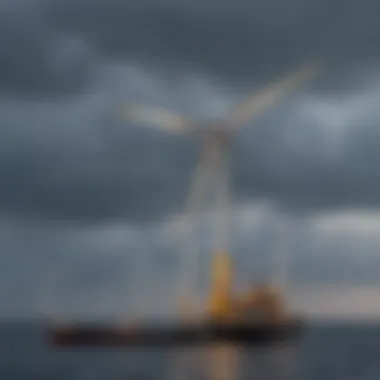
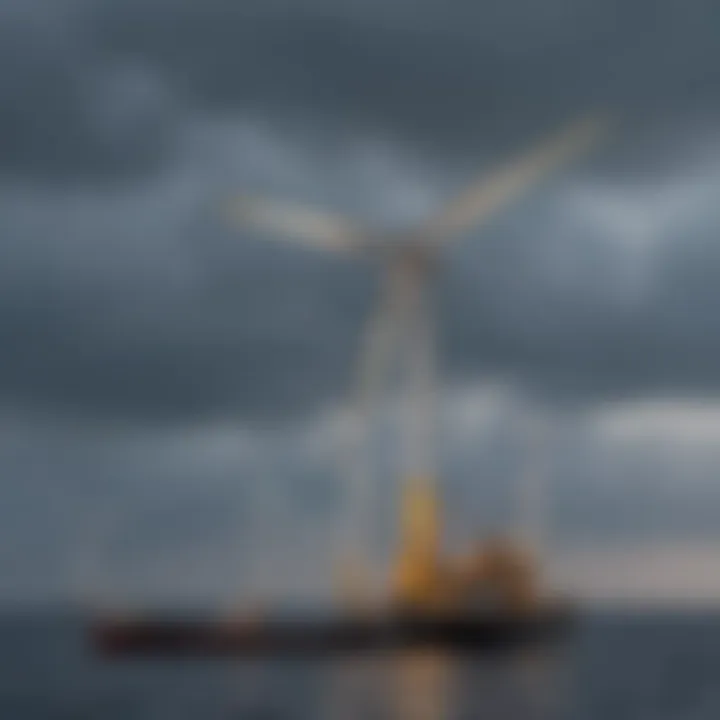
Intro
The development and installation of offshore wind turbines are gaining momentum. This shift towards renewable energy sources reflects a global consensus on transitioning from fossil fuels to sustainable alternatives. Offshore wind energy holds significant promise due to its ability to harness strong and consistent wind currents over ocean waters. However, the installation process is intricate and demands careful planning and execution. It involves several stages, including site selection, engineering designs, and legislative compliance.
This article will detail the technical and logistical challenges faced throughout the installation process. It is imperative for students, researchers, and professionals to understand these complexities to grasp the evolving landscape of renewable energy solutions.
In the following sections, we will delve into key findings, methodology involved in installations, and discuss the challenges and advancements in offshore wind turbine technology.
Preface to Offshore Wind Energy
The shift towards renewable energy sources is not a mere trend; it is a necessity. Offshore wind energy plays a crucial role in the global energy transition, contributing significantly to decreasing reliance on fossil fuels. This section sheds light on the significance of offshore wind energy, its evolution, and the considerations surrounding its development.
Importance of Renewable Energy Sources
As environmental concerns escalate, the demand for renewable energy sources has intensified. Renewable energy, including offshore wind, reduces greenhouse gas emissions and helps combat climate change.
Here are some of the key reasons why renewable energy sources are vital:
- Reduction in Carbon Footprint: By utilizing wind, solar, and other forms of renewable energy, we can significantly lower the amount of carbon dioxide emitted into the atmosphere, aiding in stabilizing global temperatures.
- Energy Independence: Countries can reduce dependency on imported fuels, enhancing national security and economic resilience.
- Job Creation: The renewable sector, particularly offshore wind, creates numerous job opportunities across various skills, from installation to maintenance.
- Sustainable Development: Utilizing renewable resources aligns with sustainable development goals, ensuring that energy needs can be met without compromising future generations.
Global Trends in Offshore Wind Development
The offshore wind sector has witnessed remarkable growth over the past decades. Countries around the world are investing in this technology, recognizing its potential as a clean, sustainable energy source.
Significant trends in offshore wind development include:
- Increased Capacity: Many countries have launched ambitious plans to increase offshore wind capacity. For example, the European Union aims to have 300 GW of offshore wind capacity by 2050.
- Technological Advancements: Innovations in turbine design, such as larger, more efficient turbines, have streamlined the energy generation process.
- Global Collaborations: International partnerships are forming to share knowledge and technology, facilitating the expansion of offshore wind energy initiatives.
As countries pursue these developments, they must consider environmental impacts and regulatory frameworks that guide sustainable installation practices.
"Offshore wind energy represents a significant opportunity for countries to harness untapped resources, providing cleaner energy solutions for the future."
Through examining these crucial elements, the article further explores the complex process of offshore wind turbine installation, highlighting the technical requirements, logistical challenges, and environmental considerations inherent in this evolving field.
Understanding Offshore Wind Turbines
Understanding offshore wind turbines is crucial for comprehending the broader field of offshore wind energy. These turbines are not only the physical embodiment of the wind energy sector but also represent significant advancements in engineering and technology. Their design and operation directly influence the performance and efficiency of offshore wind farms.
In many respects, offshore wind turbines are a convergence of nature and technology. They harness wind, a renewable energy source, converting it into electricity to meet the growing global energy demands. Moreover, these turbines maximize energy output by exploiting higher wind speeds often found offshore, indicating their pivotal role in sustainable energy transition.
Types of Offshore Wind Turbines
There are several types of offshore wind turbines, each designed specifically to optimize energy capture under varying environmental conditions. The primary categories include:
- Fixed-bottom turbines: These are affixed to the seabed and are best suited for shallow waters, typically up to 60 meters deep.
- Floating turbines: As the name suggests, these turbines are designed to float on the water's surface, making them ideal for deeper waters where fixed structures are not feasible.
Each type has its own unique benefits and technical specifications. Fixed-bottom turbines generally have proven technology and lower installation costs. Meanwhile, floating turbines enable deployment in deeper, more advantageous wind sites, significantly increasing potential energy harvest.
Technological Innovations in Turbine Design
The field of offshore wind turbine design has seen remarkable innovations recently. These advancements enhance energy production while minimizing ecological impacts. Innovations include:
- Larger rotor diameters: Larger blades capture more wind energy, resulting in higher efficiency. This increase enables turbines to generate more power even at lower wind speeds.
- Advanced materials: New materials for turbine blades are lighter and stronger, facilitating larger designs without adding structural risks.
- Smart technologies: Integration of sensors and AI allows turbines to adapt to environmental conditions, optimizing energy production in real-time. These systems improve the operational efficiency of the turbines and help in predictive maintenance.
"The advancement in turbine technology is essential for reaching renewable energy targets and reducing carbon emissions."
In summary, understanding offshore wind turbines involves examining their types and the technological innovations that drive their development. This knowledge not only illuminates their critical role in harnessing wind energy but also reflects the ongoing evolution within the renewable energy landscape.
Site Selection for Offshore Wind Farms
Site selection is a critical phase in the development of offshore wind farms. It dictates not only the feasibility of the project but also its overall efficiency and environmental impact. The ideal site can maximize energy production while minimizing costs and ecological disturbance. Failure to select an optimal location can lead to increased operational challenges and regulatory hurdles, adversely affecting the project timeline and budget.
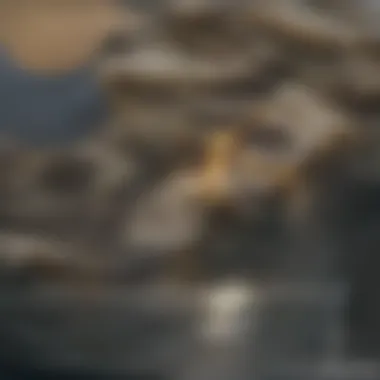
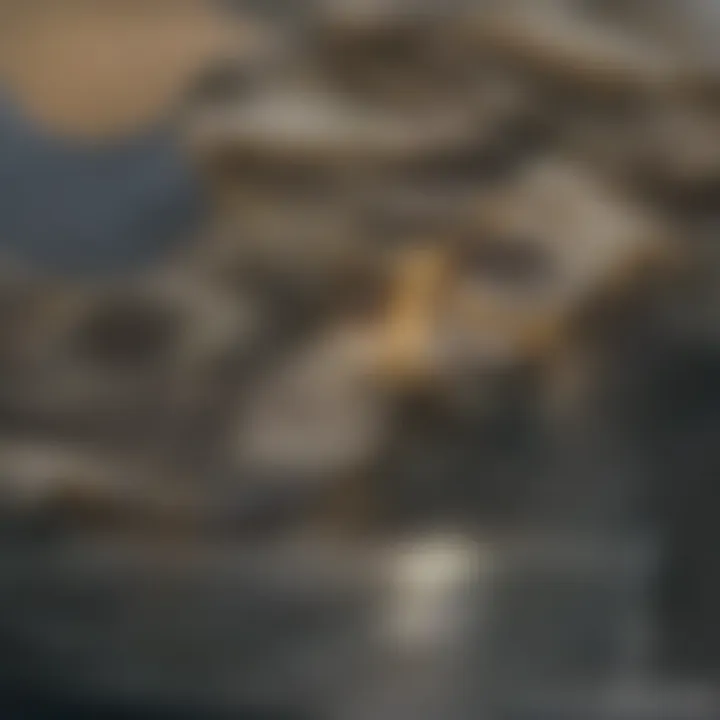
Evaluating Geographic and Environmental Factors
When selecting a site for an offshore wind farm, geographic and environmental factors are of utmost importance. These include bathymetry, wind patterns, and proximity to existing infrastructure. The depth of the water is crucial, as it influences the type of foundation that can be used for the turbines. Shallow waters tend to be more favorable for fixed foundations, while deeper waters may necessitate floating turbines.
Additionally, understanding the wind profiles in the area helps in predicting the potential energy output of the wind farm. Consistent and strong wind patterns increase the efficiency of energy generation. The environmental impact assessment should also consider local wildlife, marine ecosystems, and potential effects on fishing activities. It is essential to minimize disruption to these systems which are crucial for maintaining ecological balance.
Key factors to evaluate include:
- Water Depth: Determines foundation type and installation method.
- Wind Speed & Direction: Influences turbine efficiency and placement.
- Ecological Concerns: Protecting marine life and habitats.
- Proximity to Transmission Lines: Reduces connection costs and enhances grid stability.
Regulatory Compliance and Site Licensing
Regulatory compliance is a significant aspect of offshore wind farm site selection. Each country has specific legal frameworks governing the development of such energy projects. Obtaining the necessary permits involves navigating through complex legislative landscapes. Developers must familiarize themselves with local, national, and sometimes international regulations that govern marine activities and energy production.
Licensing usually requires submitting detailed environmental assessments, project plans, and sometimes undergoing public consultations. The process can be lengthy, often taking years to complete. Thus, it is vital for project developers to start this phase early in the project lifecycle to avoid delays.
In addition to traditional permits, developers should also consider the need for cooperation with various stakeholders, such as fisheries, navigation authorities, and local governments. This engagement can facilitate smoother project execution and mitigate potential conflicts.
- Essential Steps for Regulatory Compliance:
- Research applicable laws and regulations.
- Engage with local communities and stakeholders.
- Prepare environmental impact assessments.
- Submit applications for site licenses and permits.
Effective site selection is not just about finding a location; it is an intricate process that involves evaluating environmental concerns and navigating regulatory requirements. Failure in these areas can jeopardize the entire project.
Selecting the right site for offshore wind farms is fundamental. It requires thorough analysis and strategic planning to ensure that the project's potential is fully realized while conforming to necessary regulatory standards.
Project Planning and Management
Project planning and management play a crucial role in the successful installation of offshore wind turbines. This phase establishes the groundwork for the entire project, ensuring that all elements align with the strategic goals and objectives. Effective project planning allows for the identification of potential challenges, resource allocation, and scheduling of activities. By defining a well-structured plan, stakeholders can optimize efficiency, mitigate risks, and enhance overall project outcomes.
Defining Project Scope and Timeline
Defining the project scope is a key element in offshore wind turbine installation. This involves outlining all activities, deliverables, and objectives of the project. A clear scope reduces misunderstandings among team members and stakeholders. It serves as a reference point throughout the project's lifecycle. Monarchs of successful projects often establish criteria that indicate when the project scope is complete.
Next, establishing a timeline is essential for maintaining momentum. By providing a visual representation of the phases of work, project managers can effectively manage time constraints. This involves assigning realistic deadlines for each task, based upon both technical feasibility and potential environmental challenges. It can also facilitate coordination among various teams and external partners. Tools such as Gantt charts can be effective in tracking progress and ensuring work is performed as scheduled.
Budgeting and Financial Considerations
Financial planning is vital to the success of any offshore wind project. Budgeting helps ensure that finance is appropriately allocated across all project entities, including hiring, purchasing materials, and operational costs. The budgeting process must carefully consider the scope defined earlier. It should leave room for unexpected costs, such as equipment failure or adverse weather.
Additionally, there are several key financial considerations to address:
- Funding Sources: Identifying how the project will be financed, whether through private investors, government grants, or loans.
- Cost-Benefit Analysis: Evaluating the projected financial returns against the initial investment.
- Risk Management: Establishing a contingency budget to deal with unforeseen issues that may arise during the installation.
In this regard, a successful project not only meets its financial objectives but provides a clear framework to adapt and optimize financial strategies as project conditions evolve.
"Effective project management aligns resources and timelines, paving the way for successful offshore wind turbine installations."
Clear project planning and thoughtful financial considerations can significantly influence the outcome of offshore wind projects. By prioritizing these components, industry professionals can harness the opportunities presented in offshore wind energy.
The Installation Process
The installation of offshore wind turbines is a critical phase that determines the overall success of a wind energy project. This process involves extensive planning, coordination, and skilled execution to ensure that the turbines are safely and effectively positioned at sea. The significance of this topic cannot be overstated, as it encompasses aspects ranging from logistical planning to engineering considerations. A well-managed installation process can enhance performance, extend the lifespan of the turbines, and minimize environmental impact.
Preparation and Logistics
Before installation can commence, a thorough preparation phase is necessary. This includes developing a comprehensive logistical plan that accounts for the transportation of materials and personnel. Key factors to consider during this stage include:
- Supply Chain Management: Ensure all components are delivered on time to avoid delays.
- Vessel Readiness: Select appropriate vessels for transport and installation, ensuring they meet the operational requirements.
- Environmental Assessments: Conduct studies to understand the marine ecosystem and mitigate any potential risks.
- Weather Considerations: Analyse weather patterns to identify optimal installation windows.
The coordination of these elements requires robust communication between all stakeholders, from engineers to suppliers. Improper planning can lead to significant costs and time overruns.
Assembly Techniques for Offshore Platforms
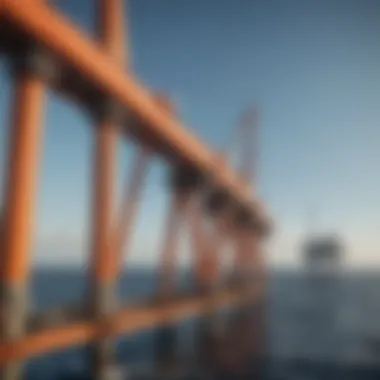
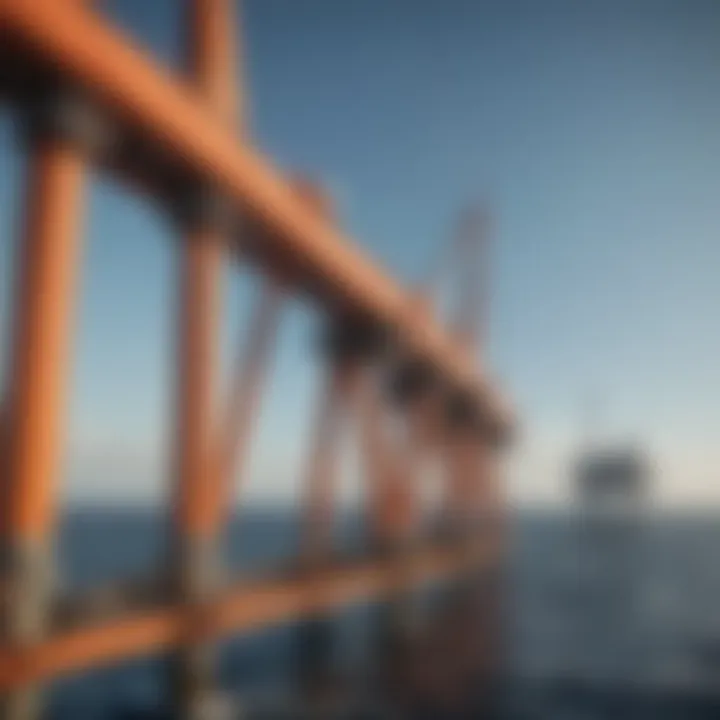
The assembly of offshore wind turbines is a precise operation that involves various techniques tailored to the turbine's design and site conditions. It typically includes:
- Pre-Assembly: Components may be assembled at a port facility before being transported to the installation site. This minimizes the time spent onsite.
- Jacking Systems: Many installations utilize jacking systems to elevate components into place, which is crucial in navigating uneven seabeds.
- Welding and Bolting: Structural integrity is ensured through the use of advanced welding techniques and bolt connections.
Each of these techniques must be selected based on the specific turbine model and environmental conditions. For instance, using specialized jack-up vessels allows for precision lifting and secure placement of turbine components, which is essential given the harsh offshore conditions.
Floating vs. Fixed Installation Methods
There are two primary installation methods for offshore wind turbines: floating and fixed installations. Each has its own set of advantages and challenges:
- Fixed Installation: This method involves securing turbines directly to the seabed using foundations. It is suitable for areas with stable soil conditions and relatively shallow waters.
- Floating Installation: Turbines are mounted on floating platforms that are tethered to the seabed. This approach offers flexibility in deeper waters where conventional fixed foundations are impractical.
Manufacturers and developers weigh the pros and cons of each method based on economic factors, environmental considerations, and project-specific requirements. Floating installations, for example, may offer more effective energy generation in deeper waters, yet they require more advanced technologies and higher initial investments.
"The success of offshore wind turbine installation relies heavily on meticulous planning and mastery of installation techniques."
Transportation and Installation Vessels
The role of transportation and installation vessels in offshore wind turbine installation cannot be understated. These vessels are essential for transporting turbine components from shore to the installation site, and their importance extends beyond mere transportation. In an industry that often operates in challenging marine environments, the selection and utilization of the right type of vessel can greatly affect project timelines, costs, and overall efficiency.
Key Considerations for Vessel Selection
When selecting vessels for offshore projects, several factors need consideration:
- Capacity: The vessel must have sufficient deck space and lifting capability to accommodate the large and heavy components of wind turbines.
- Mobility: Vessels should be capable of navigating in various water depths and conditions.
- Technology: Advanced technology can enhance efficiency and safety in operation.
Benefits of Properly Designed Vessels
Utilizing appropriate transportation and installation vessels ensures:
- Efficiency: Minimizes downtime during transport and installation, contributing to overall project success.
- Safety: Reduces risks associated with lifting operations and harsh weather conditions, safeguarding personnel and equipment.
- Cost-Effectiveness: Streamlined operations lead to lower costs, making renewable energy projects more competitive.
Types of Installation Vessels
There are different types of installation vessels, each designed for specific tasks in the offshore wind sector. These vessels include:
- Jack-up Vessels: These vessels are characterized by their legs that can be lowered to the seabed, elevating the platform above the water. This provides a stable base for turbine assembly.
- Floating Vessels: These are general-purpose ships equipped for transportation and installation. They rely on dynamic positioning systems for precise placement.
- Specialized Installation Barges: These barges can accommodate large components and may have cranes for assembly operations.
- Service Operation Vessels (SOVs): Primarily used for maintenance tasks after installation, SOVs transport personnel and equipment to and from wind farms.
Technological Innovations in Marine Vessels
Recent developments in marine vessel technology are reshaping offshore installations. Innovations include:
- Dynamic Positioning Systems: These systems utilize GPS and computational algorithms to keep vessels stationary in harsh marine conditions, improving safety.
- Green Technology: The industry is embracing eco-friendly fuel options, such as biodiesel and battery-operated vessels, to reduce emissions.
- Automated Cranes: Enhanced cranes increase efficiency and safety, significantly simplifying the assembly process of turbine components.
“As offshore wind energy continues to expand, the innovations in marine vessel technology will play a critical role in sustaining efficiency and environmental responsibility.”
The careful selection and advancement of transportation and installation vessels not only support effective offshore wind farms but also represent a significant investment towards future renewable energy practices.
Challenges in Offshore Installation
Offshore wind turbine installation involves several unique challenges that must be addressed to ensure project success. The offshore environment poses specific risks that differ from onshore projects. Awareness of these challenges is essential for stakeholders in this industry. Understanding how to navigate these issues can lead to more efficient installations, reduced costs, and improved performance of offshore wind farms. The successful execution of installation projects hinges on recognizing and planning for both environmental and logistical challenges.
Environmental Conditions and Their Impact
The offshore environment is inherently unpredictable. Weather conditions, including high winds, wave action, and extreme temperatures, can significantly impact installation activities. Before commencing installation, project managers must conduct thorough assessments of local weather patterns and sea conditions. This preparation helps predict potential storm events or adverse weather that could halt operations.
The impact of environmental conditions is not limited to just installation. It also influences maintenance schedules and overall turbine performance. For instance, if high waves or wind speeds delay installation, it can lead to stretched timelines and increased costs. Many sites undergo a stringent assessment phase to measure environmental risks, which helps in devising mitigation strategies.
On the other hand, certain technologies are emerging to counter these challenges. For example, advancements in simulation software allow teams to model complex environmental scenarios. This enables predictive planning, ensuring that all possible factors are accounted for before work begins. This proactive approach enhances safety and efficiency, critical for any offshore project.
Logistical Challenges in Remote Locations
Logistics in remote offshore locations can be daunting. The distance from shore necessitates careful planning in terms of transportation and supply chain management. Installation vessels spend significant time mobilizing to and from sites, which can increase costs and project duration.
Transportation of large components, such as turbine blades and nacelles, requires specialized ships that can carry heavy loads. Furthermore, the availability of these vessels can be limited. Project managers must schedule transportation well in advance to avoid delays.
Access to necessary resources also becomes more difficult as distance increases. The supply of tools, equipment, and even personnel needs meticulous coordination to ensure that everything arrives on time.


Effective logistical planning can greatly enhance the chances of on-time installation. It requires adept coordination among multiple stakeholders, from suppliers to shipping companies.
In summary, challenges in offshore installation encompass a wide range of environmental and logistical factors. Navigating these challenges is critical for successful project execution and long-term viability of offshore wind energy solutions.
Post-Installation Operations
Post-installation operations are critical to the success and longevity of offshore wind farms. Once the turbines are installed, ongoing maintenance and performance monitoring ensure they operate efficiently and safely, maximizing the energy they generate. These operations help prevent unexpected failures and extend the operational lifespan of the turbines.
Maintenance and Monitoring Techniques
Maintenance is a multifaceted aspect that involves regular inspections, repairs, and replacements of turbine components. These activities can be categorized into three primary types:
- Predictive Maintenance: This approach utilizes data analytics and sensor monitoring to anticipate failures before they happen. Continuous data collection allows operators to track the performance of key components, predicting when maintenance is needed.
- Preventive Maintenance: Scheduled inspections and routine service ensure that components are kept in optimal condition. This could involve lubricating gears, checking electrical systems, and replacing worn-out parts. Regular maintenance reduces the risk of downtime and improves overall reliability.
- Corrective Maintenance: This occurs after a failure. Once a fault is detected, immediate repairs ensure that the turbine is returned to operation. It is more costly than preventive measures and can lead to significant loss in production.
The implementation of drones and robotic technologies has revolutionized maintenance in offshore settings. They can safely conduct inspections without the need for human intervention, especially in harsh weather conditions.
Evaluating Performance Metrics
Performance metrics play an essential role in the management of offshore wind operations. Key performance indicators (KPIs) include:
- Capacity Factor: This metric measures the actual output of a wind farm compared to its potential output. A high capacity factor indicates effective turbine performance and strong wind availability.
- Availability Rate: This captures the percentage of time that a turbine is operational and able to generate power. Higher rates signal effective maintenance and reduced downtime.
- Energy Production: Tracking to determine the actual energy produced over specific periods. This information aids in forecasting revenues and operational efficiency.
Evaluating these metrics not only provides insight into operational efficiency but also helps identify areas for improvement. Through comparing historical performance data, operators can recognize patterns and trends, optimizing future performance.
"Proactive maintenance and diligent performance analysis create a sustainable framework for offshore wind operations, fostering reliability and efficiency."
In summary, post-installation operations represent a vital aspect of offshore wind energy management. Through effective maintenance techniques and thorough performance metric evaluations, operators can ensure the success of wind farms and contribute significantly to the transition towards renewable energy.
Future of Offshore Wind Energy
The future of offshore wind energy holds significant promise in the landscape of renewable energy. This section will discuss vital aspects that drive its evolution. With growing global energy demands, offshore wind farms offer a sustainable alternative to traditional fossil fuels. Their capacity to generate substantial power in windy coastal regions makes them a key player in efforts to reduce greenhouse gas emissions.
Moreover, technological advancements continue to enhance efficiency and reliability. Innovations in turbine design, including larger rotor blades and more effective materials, allow for increased energy capture. This results in higher electricity output, making offshore wind energy more economically viable. As prices for wind energy decrease, it positions itself competitively against other energy sources.
Emerging Trends and Innovations
One of the most impactful trends is the movement towards floating wind turbines. Unlike fixed-bottom turbines, floating platforms can be deployed in deeper waters where winds are stronger and more consistent. This transition broadens the potential areas for wind farm development, maximizing energy production.
Additionally, digital technologies are making waves in the sector. The integration of data analytics and IoT (Internet of Things) allows for real-time monitoring of turbine performance. Predictive maintenance becomes possible, minimizing downtime and ensuring operational efficiency. Automation also plays a crucial role, as drones and remote-operated vehicles handle routine inspections, reducing the need for human intervention in hazardous environments.
The industry is also seeing a push for hybrid systems, which integrate various renewable energy sources. Combining offshore wind with solar or energy storage solutions can create a more resilient energy grid, addressing intermittency challenges. This multifaceted approach enhances energy security and reliability.
Policy Implications and Support Mechanisms
Policies play a crucial role in shaping the future of offshore wind energy. Governments around the world recognize the need for legislative support to foster investment in this sector. Incentives such as tax credits and grants encourage private sector participation, accelerating the development of wind energy projects. Countries such as Germany and the UK have established ambitious targets for offshore wind capacity, leading to significant investments.
Moreover, international cooperation is increasingly important. Agreements between countries can lead to shared innovations, best practices, and joint investments in offshore wind technology. For instance, the North Seas Energy Cooperation aims to maximize the potential of offshore renewable energy in Europe, creating cross-border electricity grids to optimize energy distribution.
Investment in workforce development also must not be overlooked. Creating skilled labor through training programs ensures that there is a pool of professionals ready to take on challenges in installation, maintenance, and operation of offshore wind infrastructure.
The End
The conclusion serves as a vital component of this article, encapsulating the intricate processes and implications regarding offshore wind turbine installation. It highlights the significance of renewable energy and the urgency to address climate change through sustainable practices. Offshore wind energy stands out due to its capacity to generate large amounts of electricity without contributing to greenhouse gas emissions. In the context of energy diversification, it provides not only a feasible solution but also enhances energy security for nations.
Summary of Key Insights
Throughout the article, we discussed several critical aspects of offshore wind turbine installation. These include:
- Importance of Offshore Wind Energy: The need for renewable energy has never been greater. Offshore wind provides a promising source, as it typically experiences stronger and more consistent winds compared to onshore.
- Installation Process: From site selection to assembly techniques, each stage requires careful planning and execution. Innovations in turbine design and marine vessels play a crucial role here.
- Challenges Faced: Environmental factors and logistical hurdles are numerous and can significantly impact project timelines. A successful installation demands thorough risk assessment and mitigation strategies.
- Future Trends: Emerging technologies and policy frameworks can shape the landscape of offshore wind energy. Continuous investment in research will drive advancements in efficiency and sustainability.
The integration of these insights portrays a multifaceted view of the sector, emphasizing the delicate balance between innovation, regulation, and environmental stewardship.
Implications for Future Research
The offshore wind energy landscape is rapidly evolving, ushering in multiple avenues for future research. Scholars and practitioners alike can pursue various directions:
- Technological Advancements: Investigating new turbine designs or materials can yield significant improvements in efficiency and lifespan.
- Environmental Impact Studies: Understanding the ecological effects of offshore installations will be crucial for developing sustainable practices.
- Economic Analysis: A detailed assessment of the financial models supporting offshore wind projects can inform investment decisions and public policy.
- Regulatory Frameworks: Examining current regulations and proposing new policies can facilitate smoother project implementation while ensuring environmental protection.
Future research in these areas can help refine offshore wind installation practices, fostering a more effective transition to renewable energy solutions.



